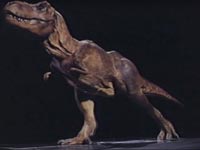
![]() There is a reason why there are no dinosaur geneticists - their careers would quickly become as extinct as the 'terrible lizards' themselves. Bones may fossilise, but soft tissues and molecules like DNA do not. Outside of the fictional world of Jurassic Park, dinosaurs have left no genetic traces for eager scientists to study.
There is a reason why there are no dinosaur geneticists - their careers would quickly become as extinct as the 'terrible lizards' themselves. Bones may fossilise, but soft tissues and molecules like DNA do not. Outside of the fictional world of Jurassic Park, dinosaurs have left no genetic traces for eager scientists to study.
 Nonetheless, that is exactly what Chris Organ and Scott Edwards from Harvard University have managed to do. And it all started with a simple riddle: which came first, the chicken or the genome?
Nonetheless, that is exactly what Chris Organ and Scott Edwards from Harvard University have managed to do. And it all started with a simple riddle: which came first, the chicken or the genome?
Like almost all birds, a chicken's genome - its full complement of DNA - is remarkably small. DNA is made up of millions of units called 'base pairs', just like a book contains millions of letters. A typical bird genome is made up of about 1.5 billion of these base pairs, just half the number of the comparatively flabby human genome. Like their bodies, bird genomes are feather-weight and streamlined.
Some scientists have suggested that, over the course of evolution, birds shrunk their genetic packages to help them fly. Smaller genomes involve less DNA, which in turn can be housed in smaller cells. And smaller cells are more energy-efficient than larger ones, in the same way that a Mini is more efficient than a gas-guzzling SUV.
To test this theory, Organ and Edwards decided to look back in time at the ancestors of all living birds, the dinosaurs. They realised that they didn't need to get their hands on actual dinosaur DNA to analyse genome sizes. In earlier work, they had shown that the size of an animal's cells is a very good indicator of the size of its genome - measure one and you can measure the other. And while dinosaur cells have long decayed, some have left their mark on fossils.
 Osteocytes, or bone cells, reside within cavities in living bone, and when they die, the hollows they leave behind reveal how big they were. By measuring these hollows in fossil bones, the team was able to estimate the cell sizes and, consequently, the genome sizes of 31 different dinosaur species. "These fossils let us sample species through evolutionary time, providing genomic information that's often unavailable for long-extinct ancestors," explains Edwards.
Osteocytes, or bone cells, reside within cavities in living bone, and when they die, the hollows they leave behind reveal how big they were. By measuring these hollows in fossil bones, the team was able to estimate the cell sizes and, consequently, the genome sizes of 31 different dinosaur species. "These fossils let us sample species through evolutionary time, providing genomic information that's often unavailable for long-extinct ancestors," explains Edwards.
They found very distinct differences between two great dinosaur dynasties. The Ornithischians, a group that includes celebrities like Triceratops and Stegosaurus, had large genomes, of comparable size to modern reptiles like crocodiles and lizards.
But those of the flesh-eating Theropods like Tyrannosaurus and Velociraptor were only half this size, about the same as the modern birds that evolved from this group. Despite its massive bulk, Tyrannosaurus rex's genome was no larger than a hummingbird's, and completely dwarfed by that of the humble house mouse.
Smaller genomes do not necessarily mean fewer genes, just a better use of space. Our own genome, for example, is replete with repetitive sequences of DNA with little obvious purpose. These are the remnants of parasitic chunks of DNA that embedded themselves among our genes during our evolution.
Organ estimated that these repetitive elements made up about 12% of the larger ornithischian genomes, but only 8% of the smaller theropod ones. This suggests that the theropod line shrunk their genomes by culling useless bits of DNA.
 These results clearly disprove the notion that smaller genomes evolved to allow birds to take to the skies. "Our work shows these streamlined genomes arose long before the first birds and flight," says Edwards. "They can be added to the list of dinosaur traits previously thought to be found only in modern birds, including feathers, parental care and nesting."
These results clearly disprove the notion that smaller genomes evolved to allow birds to take to the skies. "Our work shows these streamlined genomes arose long before the first birds and flight," says Edwards. "They can be added to the list of dinosaur traits previously thought to be found only in modern birds, including feathers, parental care and nesting."
But why did smaller genomes evolve in the first place? Organ says, "The most plausible explanation for the genome shrinkage is that smaller genome and cell sizes contributed to an elevated metabolism." Smaller cells are more energy efficient and gave the theropods a higher metabolic rate and perhaps even allowed them to become warm-blooded.
While Jurassic Park's attempts at sequencing dinosaur DNA were fiction, its portrayal of fleet-footed dinosaur hunters may have been spot on.
A higher metabolic rate could also have pre-disposed the theropod dynasty to a life in the air. And once the ability to fly arose, it may have become interlinked with small genomes, even though the two traits evolved independently.
The evidence for this comes from modern birds; those that have lost the ability to fly, like ostriches, have started to regain the larger genomes of their distant ancestors. As Organ says, "Evolution often works out that way".
Reference: Organ, Shedlock, Meade, Pagel & Edwards. 2007. Origin of avian genome size and structure in non-avian dinosaurs. Nature 446: 180-184.




Their alternative explanation for the small genome in Theropods (increased metabolism) seems a little weak. Mammals were able to get an increased metabolism and warm-bloodedness without shrinking their genomes. Also, if birds' genomes are contributing to their increased metabolism, one would expect that even ground-dwelling birds (especially speedy ones like ostriches) would continue to keep their small genomes.
What do you mean by this? The results show is that smaller genomes do not necessarily result in the evolution of flight. They do not show anything about whether or not smaller genomes 'allow' flight.
Very absorbing article. By the way, any research relating to BAT genomes? Are they shedding their junk DNA after taking to the skies? I think they have to, to gain efficiency.
It's true that mammals developed high-end metabolism with large cells and large genomes, but there's a cost associated with such a retention: risk (and prevalance) of cancer and less energy efficient endothermy associated with a higher cost of splitting cells.
Birds got around this by shrinking their cells (and genomes). Endothermy may have evolved before Dinosauria, though, so cell/genome shrinking might have more to do with energy efficiency in theropods, and less to do with the onset of endothermy.
AFAICT, arboreal archosaurs ate seeds, insects and ambushed waterside ground prey (like an owl or sabercat), so lightness (and increased feathers and homeothermy) was a definite plus. Both aves and theropods derived from these archosaurs; non-chasing non-flying descendants would re-enlarge their genomes, small chasing & flying descendants would further shrink their genomes. I think the same thing happened in flying insects (eg. Drysophila), bats and Pterosaurs. Retaining lots of "junk" DNA is very beneficial during transitional periods (eg. climate change), but not so much during stable periods, regarding general adaptability of a species, I think. (I was commenting about this at PZ's post on Limusaurus.)
AFAICT, arboreal archosaurs ate seeds, insects and ambushed waterside ground prey (like an owl or sabercat), so lightness (and increased feathers and homeothermy) was a definite plus. Both aves and theropods derived from these archosaurs; non-chasing non-flying descendants would re-enlarge their genomes, small chasing & flying descendants would further shrink their genomes. I think the same thing happened in flying insects (eg. Drysophila), bats and Pterosaurs. Retaining lots of "junk" DNA is very beneficial during transitional periods (eg. climate change), but not so much during stable periods, regarding general adaptability of a species, I think. (I was commenting about this at PZ's post on Limusaurus): http://scienceblogs.com/pharyngula/2009/06/limusaurus_inextricabilis.php
The beginning statement that there is no molecular evidence from dinosaurs is not true. DNA has been extracted from T. Rex, and Mary Schweitzer and her team have twice demonstrated they can dissolve hard tissues and find collagen and protein molecules in fossilized dinosaur bones. (See 1. Schweitzer MH, Wittmeyer JL, Horner JR. 2007. Soft tissue and cellular preservation in vertebrate skeletal elements from the Cretaceous to the present. Proc. R. Soc. Lond. B. 274:183-187; 2. Schweitzer MH, Suo Z, Avci R, Asara JM, Allen MA, Teran Arce F, Horner JR. 2007. Analyses of soft tissue from Tyrannosaurus rex suggest the presence of protein. Science 316: 277-280; 3. Mary H. Schweitzer et al. 2005. Soft-Tissue Vessels and Cellular Preservation in Tyrannosaurus rex. Science. 307: 1952 - 1955.)
Also, I don't understand the mechanism for how these species managed to cull useless DNA segments from their genome. The way this is written, it sounds as if the species did it on purpose, but that obviously can not be the case. Something must have acted on them that resulted in a differential reproductive output.
DeLene - heh, good point. I actually wrote this article two years ago, before I became aware of Schweitzer's work. I've since written about it myself!
Ah, I see. So you recycled it, but opted not to alter the lede. Any insights as to the culling cause/mechanism?